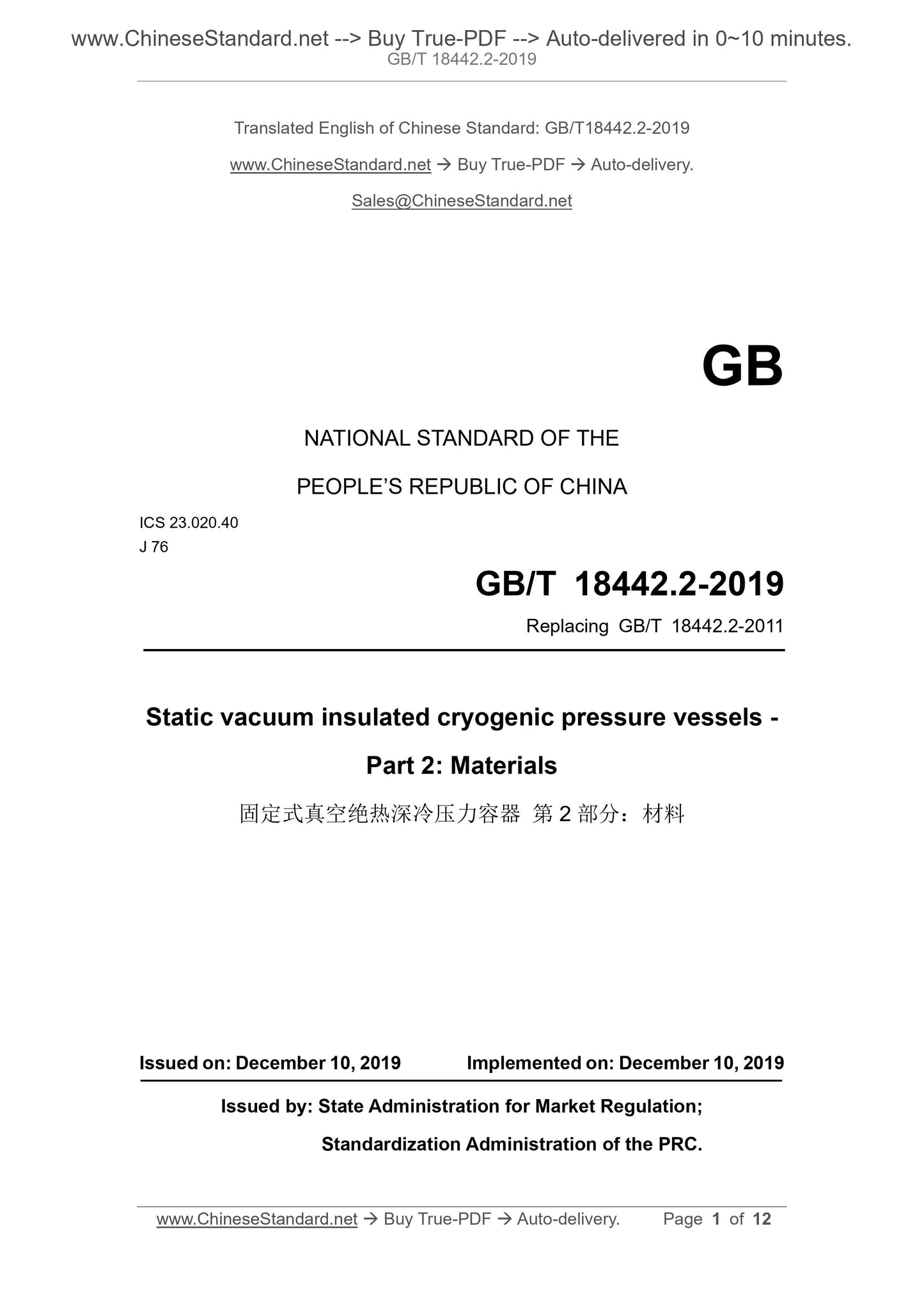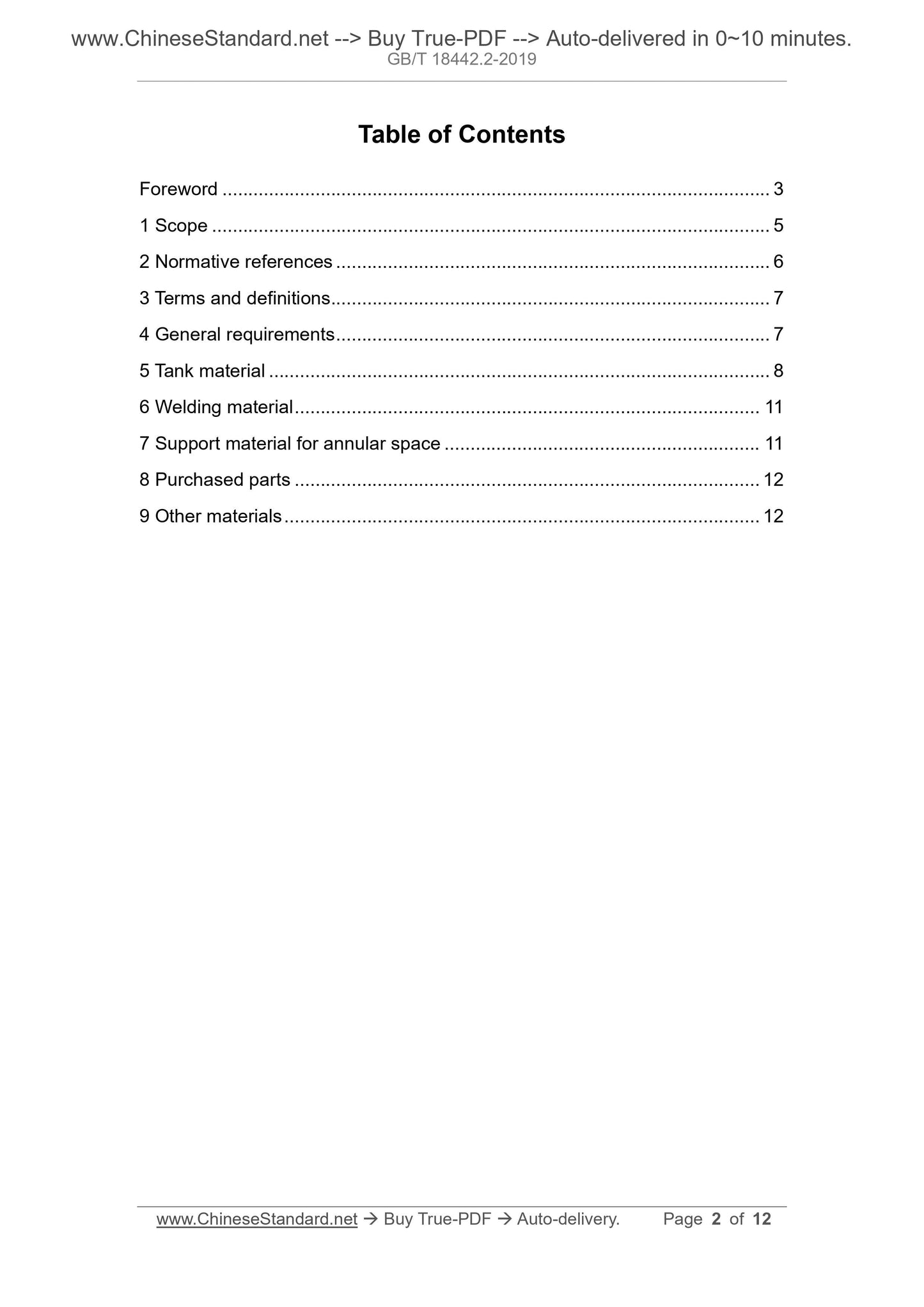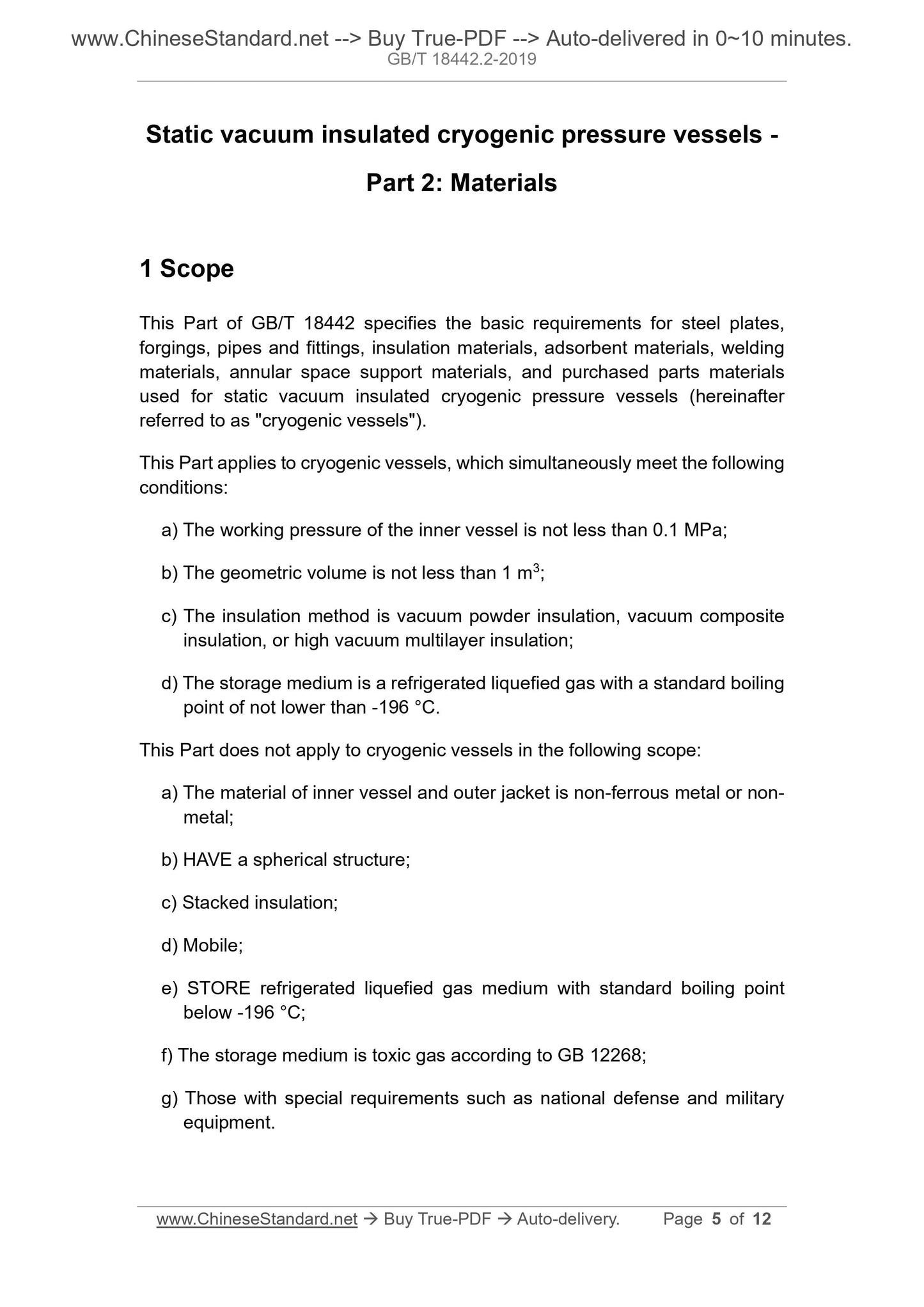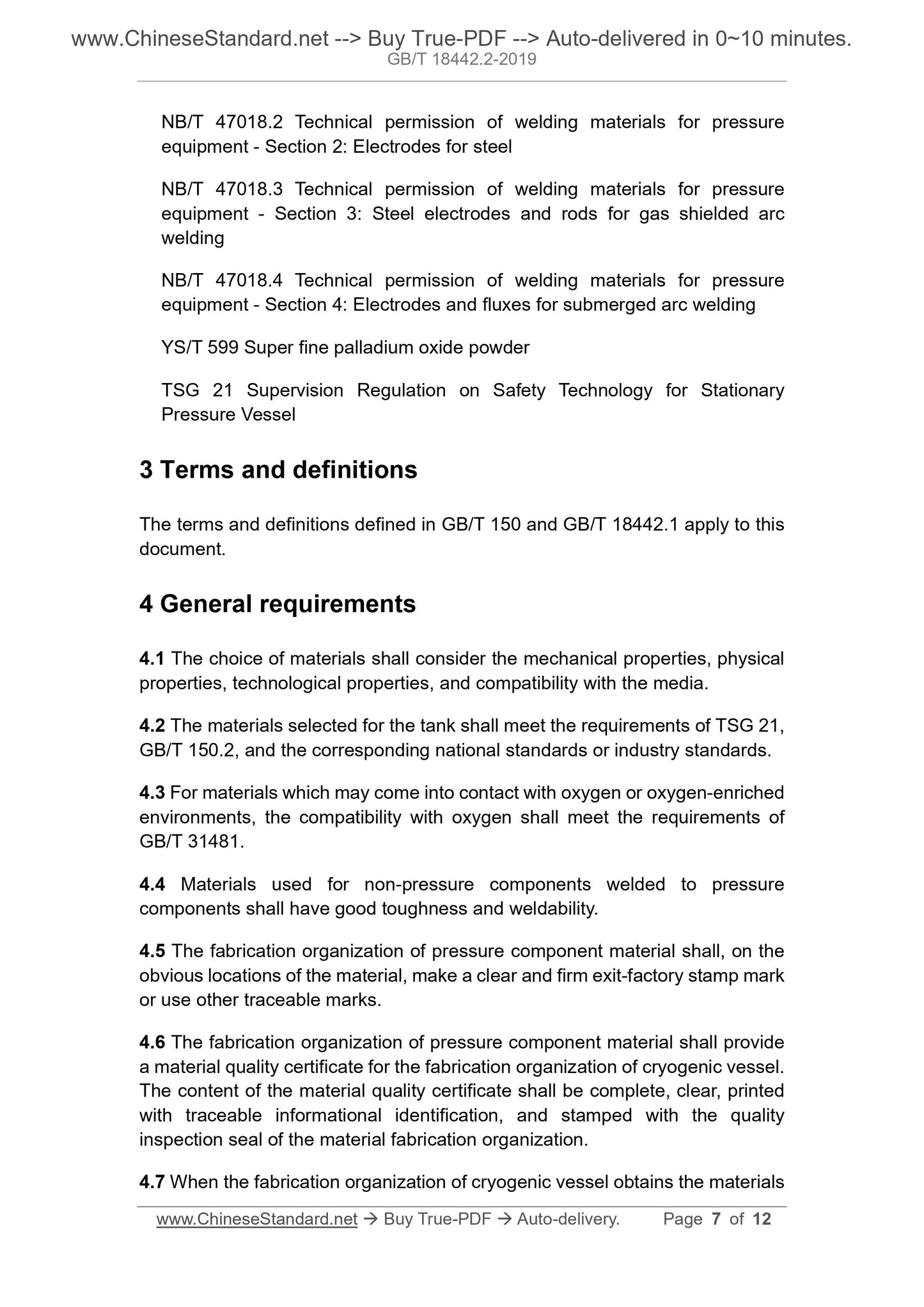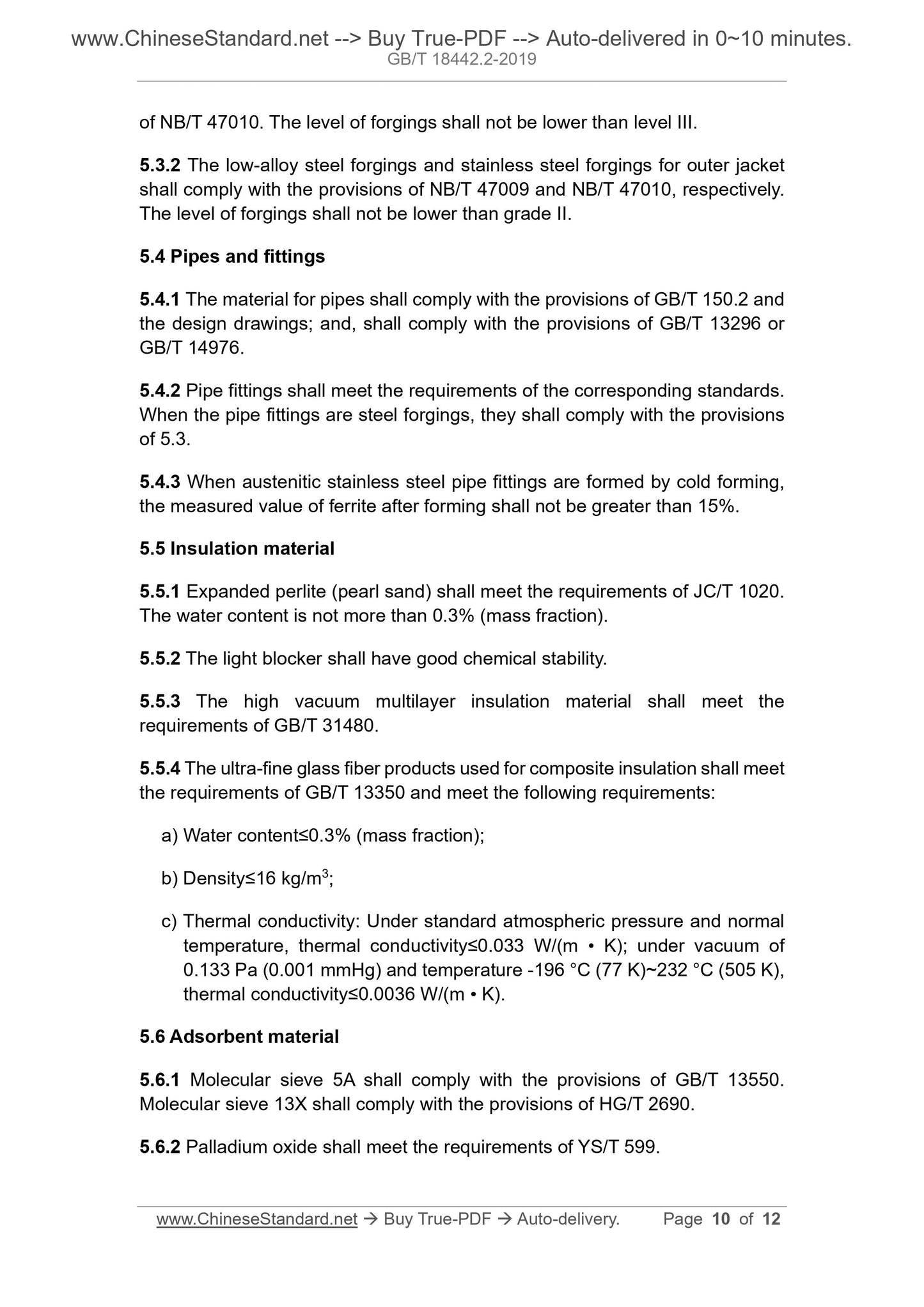1
/
of
5
PayPal, credit cards. Download editable-PDF and invoice in 1 second!
GB/T 18442.2-2019 English PDF (GBT18442.2-2019)
GB/T 18442.2-2019 English PDF (GBT18442.2-2019)
Regular price
$135.00 USD
Regular price
Sale price
$135.00 USD
Unit price
/
per
Shipping calculated at checkout.
Couldn't load pickup availability
Delivery: 3 seconds. Download true-PDF + Invoice.
Get QUOTATION in 1-minute: Click GB/T 18442.2-2019
Historical versions: GB/T 18442.2-2019
Preview True-PDF (Reload/Scroll if blank)
GB/T 18442.2-2019: Static vacuum insulated cryogenic pressure vessels -- Part 2: Materials
GB/T 18442.2-2019
NATIONAL STANDARD OF THE
PEOPLE’S REPUBLIC OF CHINA
ICS 23.020.40
J 76
Replacing GB/T 18442.2-2011
Static vacuum insulated cryogenic pressure vessels -
Part 2: Materials
ISSUED ON: DECEMBER 10, 2019
IMPLEMENTED ON: DECEMBER 10, 2019
Issued by: State Administration for Market Regulation;
Standardization Administration of the PRC.
Table of Contents
Foreword ... 3
1 Scope ... 5
2 Normative references ... 6
3 Terms and definitions ... 7
4 General requirements ... 7
5 Tank material ... 8
6 Welding material ... 11
7 Support material for annular space ... 11
8 Purchased parts ... 12
9 Other materials ... 12
Static vacuum insulated cryogenic pressure vessels -
Part 2: Materials
1 Scope
This Part of GB/T 18442 specifies the basic requirements for steel plates,
forgings, pipes and fittings, insulation materials, adsorbent materials, welding
materials, annular space support materials, and purchased parts materials
used for static vacuum insulated cryogenic pressure vessels (hereinafter
referred to as "cryogenic vessels").
This Part applies to cryogenic vessels, which simultaneously meet the following
conditions:
a) The working pressure of the inner vessel is not less than 0.1 MPa;
b) The geometric volume is not less than 1 m3;
c) The insulation method is vacuum powder insulation, vacuum composite
insulation, or high vacuum multilayer insulation;
d) The storage medium is a refrigerated liquefied gas with a standard boiling
point of not lower than -196 °C.
This Part does not apply to cryogenic vessels in the following scope:
a) The material of inner vessel and outer jacket is non-ferrous metal or non-
metal;
b) HAVE a spherical structure;
c) Stacked insulation;
d) Mobile;
e) STORE refrigerated liquefied gas medium with standard boiling point
below -196 °C;
f) The storage medium is toxic gas according to GB 12268;
g) Those with special requirements such as national defense and military
equipment.
NB/T 47018.2 Technical permission of welding materials for pressure
equipment - Section 2: Electrodes for steel
NB/T 47018.3 Technical permission of welding materials for pressure
equipment - Section 3: Steel electrodes and rods for gas shielded arc
welding
NB/T 47018.4 Technical permission of welding materials for pressure
equipment - Section 4: Electrodes and fluxes for submerged arc welding
YS/T 599 Super fine palladium oxide powder
TSG 21 Supervision Regulation on Safety Technology for Stationary
Pressure Vessel
3 Terms and definitions
The terms and definitions defined in GB/T 150 and GB/T 18442.1 apply to this
document.
4 General requirements
4.1 The choice of materials shall consider the mechanical properties, physical
properties, technological properties, and compatibility with the media.
4.2 The materials selected for the tank shall meet the requirements of TSG 21,
GB/T 150.2, and the corresponding national standards or industry standards.
4.3 For materials which may come into contact with oxygen or oxygen-enriched
environments, the compatibility with oxygen shall meet the requirements of
GB/T 31481.
4.4 Materials used for non-pressure components welded to pressure
components shall have good toughness and weldability.
4.5 The fabrication organization of pressure component material shall, on the
obvious locations of the material, make a clear and firm exit-factory stamp mark
or use other traceable marks.
4.6 The fabrication organization of pressure component material shall provide
a material quality certificate for the fabrication organization of cryogenic vessel.
The content of the material quality certificate shall be complete, clear, printed
with traceable informational identification, and stamped with the quality
inspection seal of the material fabrication organization.
4.7 When the fabrication organization of cryogenic vessel obtains the materials
of NB/T 47010. The level of forgings shall not be lower than level III.
5.3.2 The low-alloy steel forgings and stainless steel forgings for outer jacket
shall comply with the provisions of NB/T 47009 and NB/T 47010, respectively.
The level of forgings shall not be lower than grade II.
5.4 Pipes and fittings
5.4.1 The material for pipes shall comply with the provisions of GB/T 150.2 and
the design drawings; and, shall comply with the provisions of GB/T 13296 or
GB/T 14976.
5.4.2 Pipe fittings shall meet the requirements of the corresponding standards.
When the pipe fittings are steel forgings, they shall comply with the provisions
of 5.3.
5.4.3 When austenitic stainless steel pipe fittings are formed by cold forming,
the measured value of ferrite after forming shall not be greater than 15%.
5.5 Insulation material
5.5.1 Expanded perlite (pearl sand) shall meet the requirements of JC/T 1020.
The water content is not more than 0.3% (mass fraction).
5.5.2 The light blocker shall have good chemical stability.
5.5.3 The high vacuum multilayer insulation material shall meet the
requirements of GB/T 31480.
5.5.4 The ultra-fine glass fiber products used for composite insulation shall meet
the requirements of GB/T 13350 and meet the following requirements:
a) Water content≤0.3% (mass fraction);
b) Density≤16 kg/m3;
c) Thermal conductivity: Under standard atmospheric pressure and normal
temperature, thermal conductivity≤0.033 W/(m • K); under vacuum of
0.133 Pa (0.001 mmHg) and temperature -196 °C (77 K)~232 °C (505 K),
thermal conductivity≤0.0036 W/(m • K).
5.6 Adsorbent material
5.6.1 Molecular sieve 5A shall comply with the provisions of GB/T 13550.
Molecular sieve 13X shall comply with the provisions of HG/T 2690.
5.6.2 Palladium oxide shall meet the requirements of YS/T 599.
Get QUOTATION in 1-minute: Click GB/T 18442.2-2019
Historical versions: GB/T 18442.2-2019
Preview True-PDF (Reload/Scroll if blank)
GB/T 18442.2-2019: Static vacuum insulated cryogenic pressure vessels -- Part 2: Materials
GB/T 18442.2-2019
NATIONAL STANDARD OF THE
PEOPLE’S REPUBLIC OF CHINA
ICS 23.020.40
J 76
Replacing GB/T 18442.2-2011
Static vacuum insulated cryogenic pressure vessels -
Part 2: Materials
ISSUED ON: DECEMBER 10, 2019
IMPLEMENTED ON: DECEMBER 10, 2019
Issued by: State Administration for Market Regulation;
Standardization Administration of the PRC.
Table of Contents
Foreword ... 3
1 Scope ... 5
2 Normative references ... 6
3 Terms and definitions ... 7
4 General requirements ... 7
5 Tank material ... 8
6 Welding material ... 11
7 Support material for annular space ... 11
8 Purchased parts ... 12
9 Other materials ... 12
Static vacuum insulated cryogenic pressure vessels -
Part 2: Materials
1 Scope
This Part of GB/T 18442 specifies the basic requirements for steel plates,
forgings, pipes and fittings, insulation materials, adsorbent materials, welding
materials, annular space support materials, and purchased parts materials
used for static vacuum insulated cryogenic pressure vessels (hereinafter
referred to as "cryogenic vessels").
This Part applies to cryogenic vessels, which simultaneously meet the following
conditions:
a) The working pressure of the inner vessel is not less than 0.1 MPa;
b) The geometric volume is not less than 1 m3;
c) The insulation method is vacuum powder insulation, vacuum composite
insulation, or high vacuum multilayer insulation;
d) The storage medium is a refrigerated liquefied gas with a standard boiling
point of not lower than -196 °C.
This Part does not apply to cryogenic vessels in the following scope:
a) The material of inner vessel and outer jacket is non-ferrous metal or non-
metal;
b) HAVE a spherical structure;
c) Stacked insulation;
d) Mobile;
e) STORE refrigerated liquefied gas medium with standard boiling point
below -196 °C;
f) The storage medium is toxic gas according to GB 12268;
g) Those with special requirements such as national defense and military
equipment.
NB/T 47018.2 Technical permission of welding materials for pressure
equipment - Section 2: Electrodes for steel
NB/T 47018.3 Technical permission of welding materials for pressure
equipment - Section 3: Steel electrodes and rods for gas shielded arc
welding
NB/T 47018.4 Technical permission of welding materials for pressure
equipment - Section 4: Electrodes and fluxes for submerged arc welding
YS/T 599 Super fine palladium oxide powder
TSG 21 Supervision Regulation on Safety Technology for Stationary
Pressure Vessel
3 Terms and definitions
The terms and definitions defined in GB/T 150 and GB/T 18442.1 apply to this
document.
4 General requirements
4.1 The choice of materials shall consider the mechanical properties, physical
properties, technological properties, and compatibility with the media.
4.2 The materials selected for the tank shall meet the requirements of TSG 21,
GB/T 150.2, and the corresponding national standards or industry standards.
4.3 For materials which may come into contact with oxygen or oxygen-enriched
environments, the compatibility with oxygen shall meet the requirements of
GB/T 31481.
4.4 Materials used for non-pressure components welded to pressure
components shall have good toughness and weldability.
4.5 The fabrication organization of pressure component material shall, on the
obvious locations of the material, make a clear and firm exit-factory stamp mark
or use other traceable marks.
4.6 The fabrication organization of pressure component material shall provide
a material quality certificate for the fabrication organization of cryogenic vessel.
The content of the material quality certificate shall be complete, clear, printed
with traceable informational identification, and stamped with the quality
inspection seal of the material fabrication organization.
4.7 When the fabrication organization of cryogenic vessel obtains the materials
of NB/T 47010. The level of forgings shall not be lower than level III.
5.3.2 The low-alloy steel forgings and stainless steel forgings for outer jacket
shall comply with the provisions of NB/T 47009 and NB/T 47010, respectively.
The level of forgings shall not be lower than grade II.
5.4 Pipes and fittings
5.4.1 The material for pipes shall comply with the provisions of GB/T 150.2 and
the design drawings; and, shall comply with the provisions of GB/T 13296 or
GB/T 14976.
5.4.2 Pipe fittings shall meet the requirements of the corresponding standards.
When the pipe fittings are steel forgings, they shall comply with the provisions
of 5.3.
5.4.3 When austenitic stainless steel pipe fittings are formed by cold forming,
the measured value of ferrite after forming shall not be greater than 15%.
5.5 Insulation material
5.5.1 Expanded perlite (pearl sand) shall meet the requirements of JC/T 1020.
The water content is not more than 0.3% (mass fraction).
5.5.2 The light blocker shall have good chemical stability.
5.5.3 The high vacuum multilayer insulation material shall meet the
requirements of GB/T 31480.
5.5.4 The ultra-fine glass fiber products used for composite insulation shall meet
the requirements of GB/T 13350 and meet the following requirements:
a) Water content≤0.3% (mass fraction);
b) Density≤16 kg/m3;
c) Thermal conductivity: Under standard atmospheric pressure and normal
temperature, thermal conductivity≤0.033 W/(m • K); under vacuum of
0.133 Pa (0.001 mmHg) and temperature -196 °C (77 K)~232 °C (505 K),
thermal conductivity≤0.0036 W/(m • K).
5.6 Adsorbent material
5.6.1 Molecular sieve 5A shall comply with the provisions of GB/T 13550.
Molecular sieve 13X shall comply with the provisions of HG/T 2690.
5.6.2 Palladium oxide shall meet the requirements of YS/T 599.
Share
